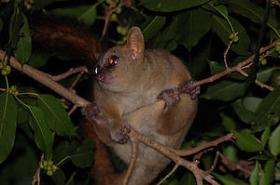New population of rare giant-mouse lemurs found in Madagascar

(PhysOrg.com) -- A new population of rare giant mouse lemurs was discovered in southwestern Madagascar?s Ranobe forest, World Wildlife Fund said.
Last year during a night survey monitoring biodiversity along the gallery forest of Ranobe near Toliara while on a mission for WWF, Charlie Gardner, and Louise Jasper, came across a giant mouse-lemur (Mirza), foraging within fruiting Ficus spp.
Two species of Mirza are currently known; Mirza coquereli and M. zaza. Mirza coquereli (Coquerel's Mouse-lemur) is found in the southwestern spiny forest eco region, but has never been seen in this particular area before.
Coquerel's Mouse-lemurs are “near threatened” according to IUCN which means that they might qualify for vulnerable, endangered or critically endangered in the near future. Their population trend is decreasing. The discovery of a new population is exciting as it raises hopes for the species’ survival.
The observed species from the Ranobe gallery forest, according to the researcher Charlie Gardner exhibits “significant differences in the coloration of its coat from the other two species. “
“The specimen that we observed appears to have a lighter dorsal coloration than is noted for M. coquereli, and has conspicuous reddish or rusty patches on the dorsal surface of the distal ends of both fore- and hind-limbs. The ventral pelage is also conspicuously light in color, and the animal possesses a strikingly red tail, also becoming darker at the end.”
“This is to suggest that it may not only be a new population, but a new species or subspecies”. However, Gardner says that the animal has to be trapped, examined and tested before it can be officially described as a new species.
These findings not only highlight the biological importance of the area, but also emphasise how little we know about these rapidly disappearing forests. Without the creation of new protected areas, we would risk losing species to extinction before they have even been discovered or described.
These animals, in turn, can attract tourism and conservation revenue to the site which can help local communities to find less destructive ways to meet their development needs.
This new lemur population is not the first exciting discovery from Ranobe in recent years. In 2005, scientists described the rediscovery of Mungotictis decemlineata lineata, a subspecies of the narrow-striped mongoose that had not been observed since 1915, and which was only ever known from a single specimen. This subspecies may be entirely restricted to the new protected area.
The representative of the new Mirza population was discovered just outside the limits of the protected area. It highlights the critical need to extend the limits of this protected area.
This area PK32-Ranobe, which is co-managed by WWF and the inter-communal association MITOIMAFI, received temporary protection status in December 2008. However, due to the presence of mining concessions, the limits of the protected area did not extend to include the gallery forests of Ranobe.
“It is a hotspot of biodiversity clamped on almost all sides by mining concessions. WWF is currently applying for the extension of the PA to include more key habitats within the decree of definitive protection,“ Malika Virah-Sawmy, WWF’s Terrestrial Programme Coordinator in Madagascar said.
Every year, large areas of Ranobe forests are felled by charcoal sellers, and in the past, much of the region was granted for mining concessions for the various minerals deposited in its rich sand soils. Meagre crops of maize are also planted on the calcareous soils, after felling and burning the forests.
The new protected area is part of a new philosophy promoted by WWF for the Durban Vision which aims to triple the surface area of Madagascar protected areas. WWF aims to empower communities to co-manage PA and to find ways for communities to benefit economically protecting their environment.
Gardner’s research, based at the University of Kent, is focused on reconciling conservation and sustainable rural development within new protected areas. This research will inform the management of PK32-Ranobe, allowing the identification of win-win scenarios that benefit all stakeholders.
“We hope the area will not only represent the single most important conservation area within the Spiny forest, but also a place where communities are benefiting from conservation through ecotourism and other sustainable livelihoods”. says Virah-Sawmy.
Provided by World Wildlife Fund

















